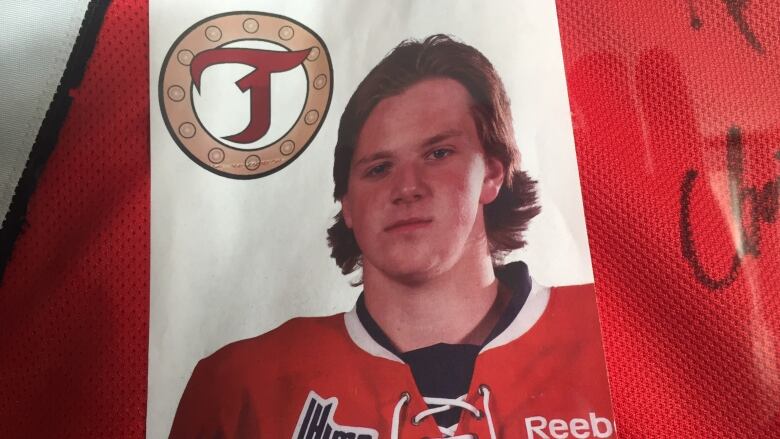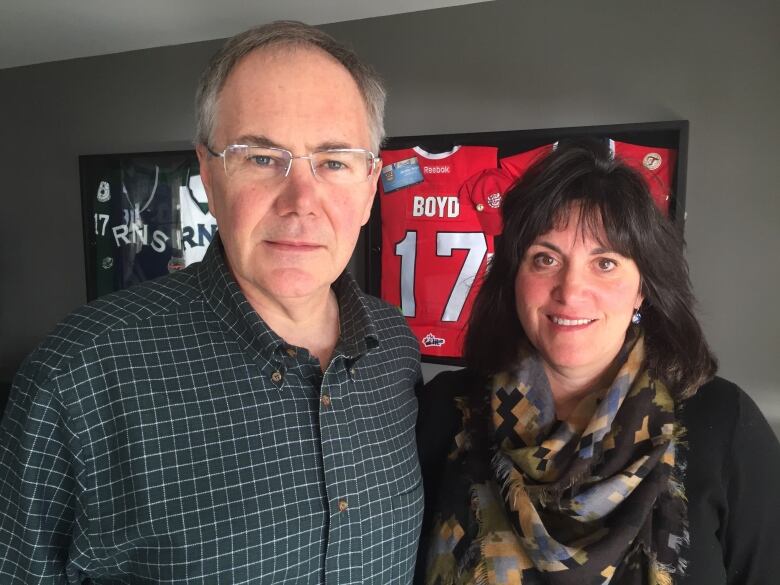Major junior hockey league apologizes 4 years after teen player's death
Quebec Major Junior Hockey League says it is improving first-aid protocols in wake of Jordan Boyd's death

The family of a teenage Nova Scotia hockey player who died after suffering a cardiac arrest on the ice four years ago is welcoming an apology from the Quebec Major Junior Hockey League (QMJHL) and the introduction of changes aimed at improving player safety.
Jordan Boyd, 16, had an undiagnosed heart condition when hecollapsed and died inBathurst, N.B., at a training campfor the QMJHL'sAcadie-Bathurst Titan,inAugust 2013.
After initially defending its actions, the league now says it's become clear that critical "first-aid readiness" needs to improve. On Tuesday, it acknowledged the Boyd family's determination to improve safety and apologized for the pain the league caused.
"The league has learned from this tragedy and is committed to learning from how this matter was handled,"QMJHLcommissioner GillesCourteausaid at a news conference.

"I'm very pleased,"said Jordan's mother, Debbie Boyd. "I feel that Jordan is getting some justice and that it's bringing more awareness and that it's all positive change."
A CBC News investigation in 2014found more than 10 crucial minutes passed between the time Jordan fell to the ice and when responders shocked him with an automated externaldefibrillator, also known as an AED.
Paramedics who arrived on the scene reported seeing no AED next to Jordanand were concerned the CPR performed by team staff was ineffective because he was still wearing his chest protector.
Timing of AED use critical
There isno guarantee an earlier shock would have saved Jordan's life, but the chances of survival are considerably better if an AED is applied in the first five minutes.
The changes announced Tuesday to the QMJHL's safety protocol include:
- Eachteam must have at least three team staff trained in CPR and life-saving techniques, including the use of an AED. Two of these trained staff are to be at all team events, games, practicesand tryouts.
- Each team shall have its own AED, which will be in the possession of the trainer/athletic therapist at all team events. This person will ensure the AED is in good working order.
- Each year, teams must report to the league which staff aretrained in life-saving techniques and confirm their certification and annual refresher training.
- The league will audit each team every year to make sure they comply.
"Hopefully, if this were ever to happen again to a player in the Quebec Major Junior Hockey League, teams will be better prepared for it and that person would have a better chance,"said Steve Boyd, Jordan's father.
During the news conference, Courteauapologizedfor what he said was information put out at the time that "turned out to be lacking in accuracy."
The league did not specify what was inaccurate. But it said shortly after Jordan's death that its safety policy had been followed "to the letter." It subsequently reviewed more thoroughly what happened and decided changes were needed.
More thorough exams promised
An autopsy revealed Jordan had a condition known as arrhythmogenic right ventricular cardiomyopathy (ARVC). The six-foot-one, 190-pound player was in great shape andhad passed a full medical exam leading up tothe camp, but cardiac exams were not part of that screening.
Most ARVC cases can be detected with an echocardiogram or MRI, but not necessarily with the more basic electrocardiogram.
The Boyds argued even an electrocardiogram would detect suchconditions in some athletes. But the league saidit has no plans to introduce that kind of mandatory screening.
However, the QMJHLsaidit will conduct more thorough physical examinations of players and has expanded parts of its health questionnaire, including a section on cardiovascular risk. It will also remind players that neither precaution is a substitute for in-depth screening.
When CBC News asked the league in 2014 whether the protocol around AEDs and CPR should be updated, a spokesperson saidit didn't feel changes were necessary.
And while it hasbecome increasingly common to install AEDs in public spaces likerinks and community centres, across the country, there remainsa patchwork of policies around registering them.
The league also said Tuesday it will contribute more than $50,000over five years to the Jordan Boyd Foundation, which distributes post-secondary scholarships to amateur hockey players.
The Boyd family holds an annual celebrity hockey tournament in Jordan's name. Proceeds support research at the QEII Inherited Heart Disease Clinic in Halifax. In four years, the event has raised more than $500,000.
"Jordan, in my mind, in my opinion, is still saving lives,"saidDebbie Boyd.













_(720p).jpg)


 OFFICIAL HD MUSIC VIDEO.jpg)
.jpg)



























































































